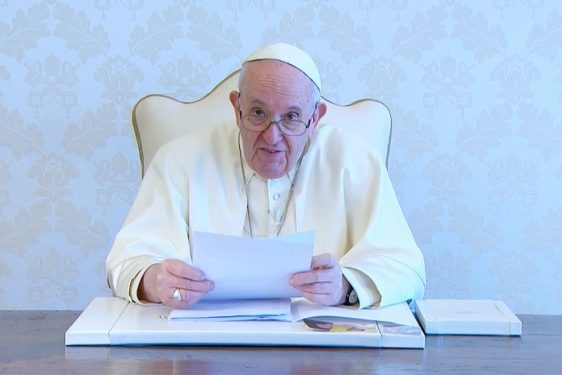By Elise Ann Allen
ROME (Crux) — On Monday, July 12, the communications platform of the Scottish bishops all but confirmed Pope Francis’ visit for a UN climate summit in November, meaning the pontiff appears to have an increasingly busy travel itinerary once he recovers from last week’s colon surgery.
On the same day he went into the hospital to have a planned surgery for a condition called “stenotic diverticulitis,” meaning a restriction of the colon with either inflammation or infection pouches along the wall of the lower intestine, Pope Francis announced that he would be traveling to Hungary and Slovakia in September.

Speaking to pilgrims during his July 4 Angelus address just hours before his surgery took place at Rome’s Gemelli Hospital, the pontiff said that “God willing,” he would visit the two countries from Sept. 12-15, stopping first in Hungary the morning of Sept. 12 to celebrate the closing Mass of the International Eucharistic Congress in Budapest.
After Mass, he will travel to Slovakia, where he will make stops in the nation’s capital, Bratislava, as well as the cities of Presov, Kosice, and Sastin.
The last pope to visit the country was St. John Paul II in 2003.
Details of Pope Francis’ trip will be announced at a later date, but Vatican spokesman Matteo Bruni confirmed that the Holy Father had been invited by both the civil and ecclesial authorities of each country.
For months it has also been speculated that the pontiff would also travel to Scotland in November for the COP26 United Nations Climate Change Conference, which will run from Oct. 31-Nov. 12 in Glasgow.
In a July 12 communique, the Scottish Media Office, the formal communications platform of the Scottish Bishops’ Conference, confirmed the pontiff’s plan to visit, quoting a spokesperson for the bishops’ conference as saying the bishops would be happy to meet with him while he’s in town.
After wishing Pope Francis a rapid recovery from his recent surgery, the spokesperson said, “Having written to the Holy Father to assure him of a warm welcome, should he attend the Conference, [the bishops] are delighted to hear that he does hope to attend and would be glad to meet with them in Glasgow.”
“The Pope will be in Scotland for a very short time, most of which will be spent participating in the COP26 Conference. While many pastoral, ecumenical, and interfaith gatherings would be desirable while he is with us, time constraints sadly mean such a full program will not be possible,” the spokesperson added, implying that current plans for the visit indicate it will be brief.
Keeping travel short with a light itinerary would not be an unsurprising move given the procedure Pope Francis just underwent, called a “hemicolectomy,” in which a portion of the left side of his colon was removed.
Although the Holy Father was expected to be discharged after seven days, the Vatican announced Monday that he will stay in the hospital for “a few more days” in order to “optimize medical and rehabilitative therapy.”
Even if Pope Francis is discharged this week as expected, doctors and medical experts predict it could take weeks for the pontiff to recover enough to resume his normal duties.
His fall schedule is already packed, with several trips planned, a synod of bishops to prepare for, and a new apostolic constitution reconfiguring the Roman Curia to publish. The Vatican also announced recently that it had indicted nine people on criminal charges related to a shady London real estate deal, with the first hearing set for later this month.
Although he is on vacation for the months of July and August, with plenty of time to rest apart from select public audiences beginning again the first week of August, this will undoubtedly affect his workload and the pace at which he is able to go once things pick back up in the fall.
Often compared to the likes of the energizer bunny for his seemingly inexhaustible stamina and charisma, widely considered remarkable for an 84-year-old who suffers from sciatica and who is missing part of a lung, Pope Francis will have to slow down a bit in coming months as his recovery continues, and this goes for trips as well.
While he appears to be healing up well, appearing on a balcony from the 10th floor of the Gemelli hospital for his July 11 Sunday Angelus address, which he stood for the whole time, his schedule may have to become lighter, and the trips he takes shorter and less demanding.
An avid traveler, Pope Francis has on average made at least 1-2 long international trips — lasting five days or more — a year for the past several years, yet recently there has been an increasing preference for shorter daytrips, or with one or two overnight stays.
This trend is likely to continue, and as he recovers from surgery, it is unlikely that Pope Francis makes any major travel plans this year, sticking instead to shorter trips as he continues to recover from his surgery.
St. John Paul II also had a reputation as a globe-trotting pope, traveling more frequently and more broadly than any of his predecessors had, yet he began to slow down in the later years of his pontificate, choosing to make increasingly brief, and less demanding international visits.
